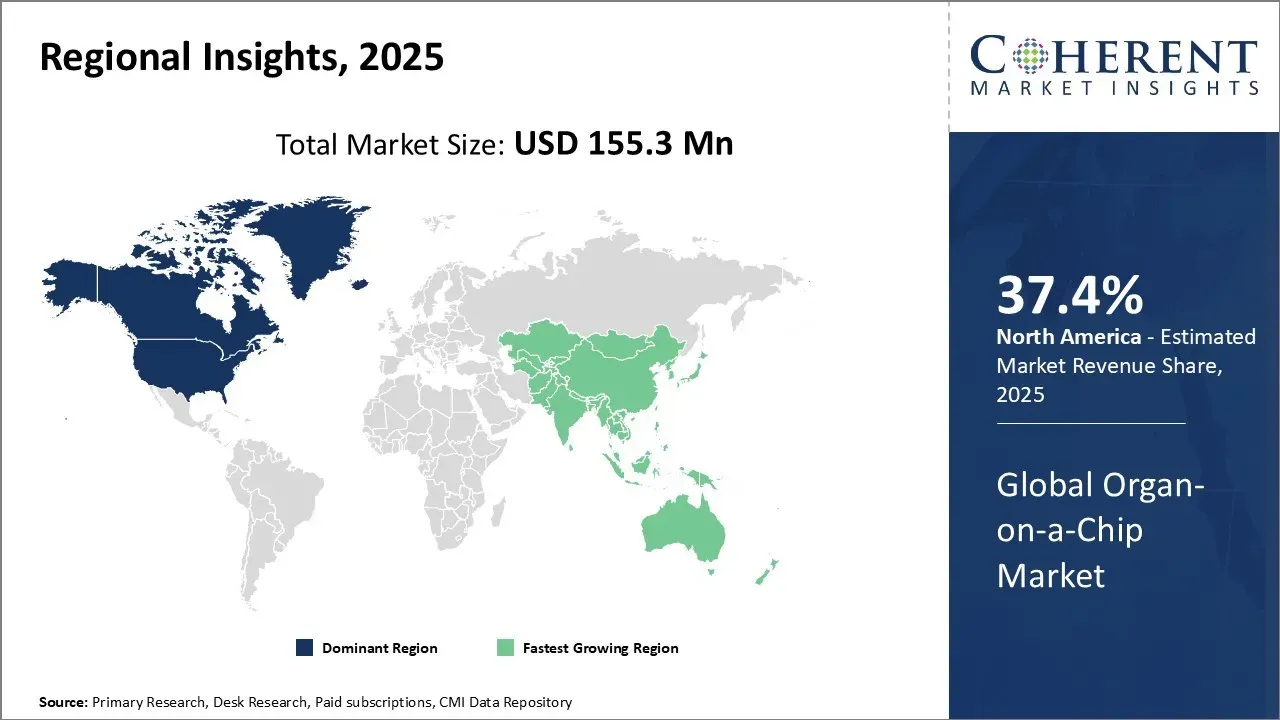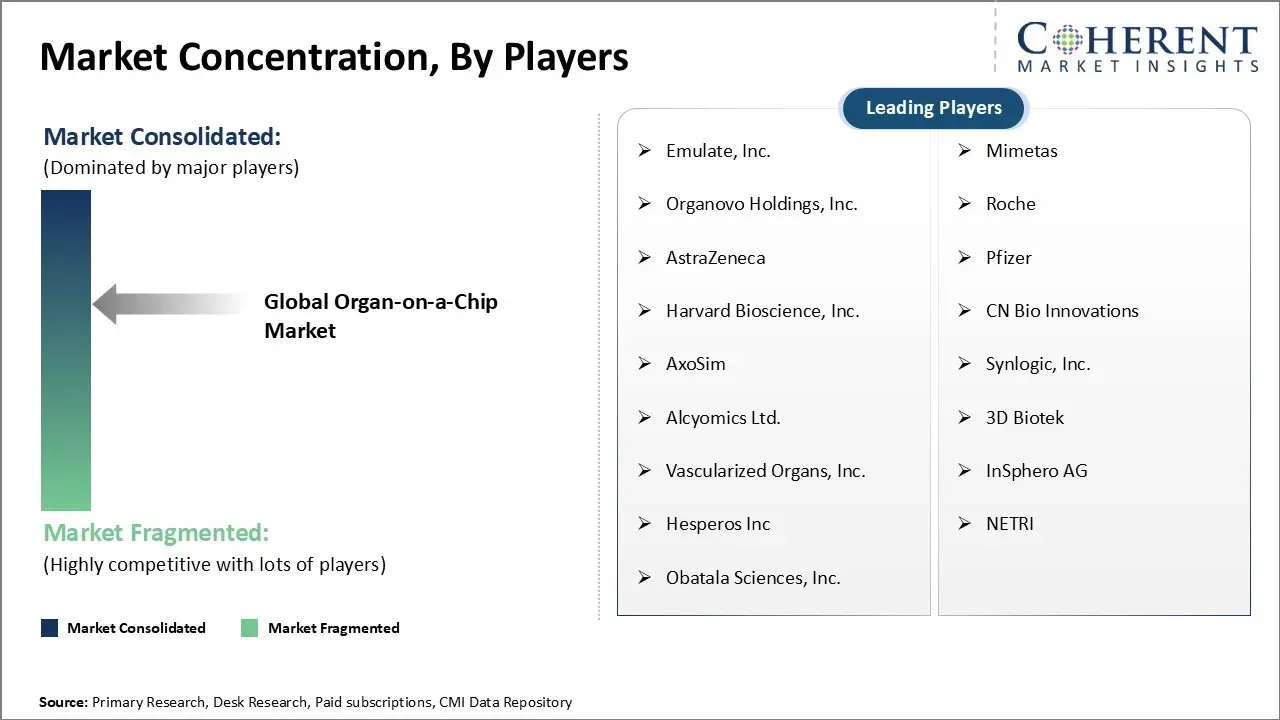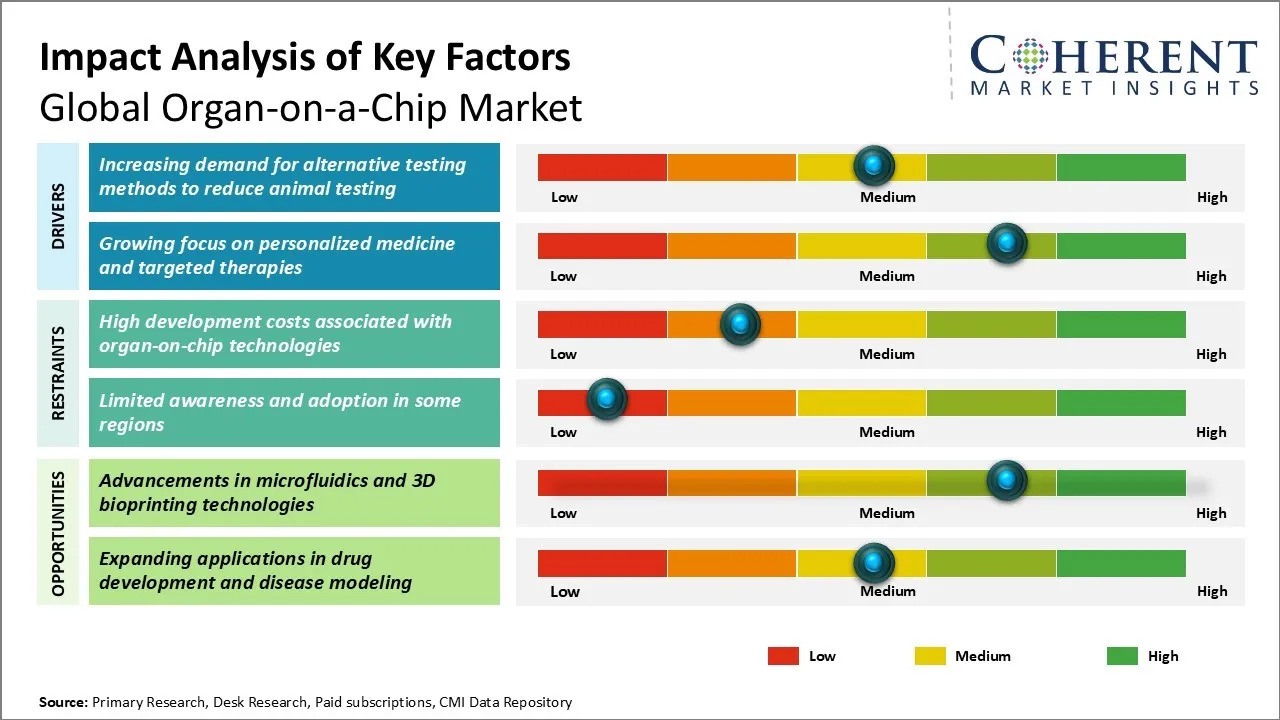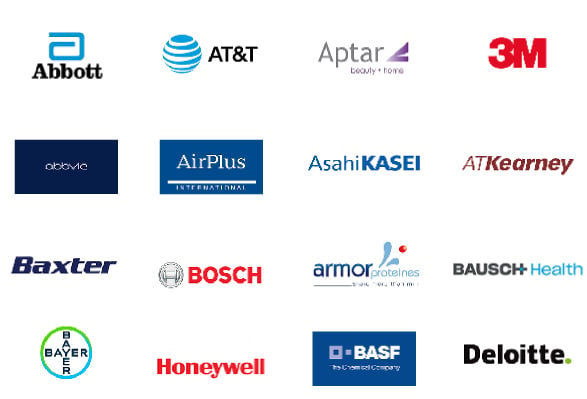The Global Organ-on-a-Chip Market is estimated to be valued at USD 155.3 Mn in 2025 and is expected to reach USD 1,211.1 Mn by 2032, exhibiting a compound annual growth rate (CAGR) of 34.1% from 2025 to 2032.
Key Takeaways of the Organ-on-a-Chip Market:
Market Overview:
The increasing need for alternative methods for drug screening and the growing focus on developing organ-level models of disease pathology are major factors expected to drive the demand for organ-on-a-chip devices. Furthermore, increasing collaborations between research academics and market players to develop more sophisticated organ-on-a-chip platforms will further augment the market growth. Availability of funding from private and public organizations for research on microfluidic devices is also expected to propel the organ-on-a-chip market during 2025-2032. However, the high costs associated with organ-on-a-chip systems may hamper market growth to some extent during the forecast years.
Products & Service Insights - Accessibility and utility driving demand for products
In terms of products & service, the products segment is expected to contribute the highest share of the market with 52.1% in 2025 owing to their accessibility and utility in research. Organ-chips allow replicating human physiology and pathology more effectively than traditional models. Products like heart-on-chip and lung-on-chip provide affordable access to cutting edge microchip technologies. Their small size and compatibility with laboratory equipment enables convenient experimentation. Complex human tissues are recreated on these chips with precision and real-time monitoring capabilities. Researchers can gain deeper insights into organ functions and disease mechanisms, without restrictions of traditional animal or cell-based models. The products also find wide acceptance due to replicating multiple organ interactions critical for advanced trials. Their portability facilitates collaborative research worldwide. The storage stability of organ tissue on chips aids product longevity.
Application Insights - Efficiency and predictability is driving toxicology testing
In terms of application, the toxicology testing segment is expected to contribute the highest share of the market with 33.4% in 2025 owing to efficiency and predictability benefits. Organ-chips drastically accelerate drug development by simulating human responses much earlier. They replace animal models to assess toxicity and potentially dangerous side effects in a fraction of time. Complex multi-organ interactions are replicated to gain human-relevant data predictive of clinical outcomes. This improves decision making on viable drug candidates. It avoids costs and delays from late-stage drug failures. With strict safety regulations, organ chips provide a human-focused solution to assay drugs effectively at low volumes.
End User Insights - Customization and compliance is driving adoption among pharmaceutical companies
In terms of end user, the pharmaceutical and biotechnology companies segment is expected to contribute the highest share of the market with 43.4% in 2025 due to customization opportunities and compliance with regulatory standards. Organ chips allow custom modeling of disease conditions and patient variability crucial for precision medications. Their flexible, on-demand organ mimicking solutions match unique research needs. This drives personalized insights and streamlines drug development. The human physiology replication abilities also meet regulatory standards of safety and efficacy. Organ chips comply with "Animal Rule" for medical countermeasures.

To learn more about this report, Request sample copy
North America Organ-On-a-Chip Market Trends
North America’s dominance in the organ-on-a-chip market with share of 37.4% in 2025 can be attributed to robust research funding and a strong presence of leading medical device companies in the U.S. and Canada. The region houses many top research universities that are engaged in developing advanced organ chips for applications in drug research, basic biology, and disease modeling.
Asia Pacific Organ-On-a-Chip Market Trends
The Asia Pacific region exhibits the fastest growth with share of 27.4% in 2025, led by China, Japan, and South Korea. Significant investments by governments and private players in developing local life sciences clusters are helping boost research activities in organ-on-a-chip technologies. Many companies like AstraZeneca are also stepping up efforts to commercialize organ chips.
Organ-on-a-Chip Market Outlook for Key Countries
U.S. Organ-On-A-Chip Market Trends
The U.S. market continues to be at the forefront of innovation, due to deep pockets of pharmaceutical and biotech companies that are major adopters of organ chips for preclinical research. Technology hubs on the west coast are home to several startups in this field. For instance, in February 2024, the National Institutes of Health (NIH) reported that it allocated US$34.9 billion for 58,951 grants, supporting universities, hospitals, and businesses worldwide, marking a 4.7% funding increase and a 1% rise in awards compared to the previous year. This rise in funding supports research utilizing organ-on-a-chip technologies, thereby driving market growth.
U.K. Organ-On-A-Chip Market Trends
The U.K. organ-on-a-chip market is undergoing rapid growth, fueled by its advanced infrastructure, which is expected to greatly enhance medical research opportunities across the region. In March 2024, a team of bioengineers at Queen Mary University of London, led by Professor Mr. Hazel Screen, was awarded a US$ 7.66 million grant to establish an EPSRC Centre for Doctoral Training (CDT). This center aims to prepare the next generation of scientists and bioengineers with expertise in organ-on-a-chip (OOC) technologies, fostering advancements in this innovative field.
Germany Organ-On-A-Chip Market Trends
Germany organ-on-a-chip market is anticipated to grow steadily over the forecast period. While OOC technology has the potential to replicate human lung biology, it currently lacks an integrated vascular system. To tackle this challenge, in June 2024, bioengineers from the Institute of Biomedical Engineering commenced a three-year fellowship at the Max Delbrück Center in Berlin-Buch, focusing on developing solutions to enhance vascular integration in organ-on-a-chip models.
China Organ-On-A-Chip Market Trends
China organ-on-a-chip market is projected to expand significantly over the forecast period. As highlighted in July 2024 China Daily’s press release, Chinese researchers and biotechnology companies are making strides in developing organ-on-a-chip technologies that replicate human lungs, livers, skin, and tumor metastasis. These transparent, flexible devices, ranging in size from a fingernail to a bank card, house 3D organ models created from cultured cells encased in silicone and polymer materials.
India Organ-On-A-Chip Market Trends
India organ-on-a-chip market is anticipated to witness significant growth during the forecast period. In August 2024, the government of India introduced the ‘BioE3’ policy, as announced in a September 2024 press release. This initiative aims to foster innovation in the biotechnology sector by establishing biomanufacturing facilities, bio-AI hubs, and bio-foundries.

Get actionable strategies to beat competition: Request sample copy
Key Developments:
Top Strategies Followed by Global Organ-on-a-Chip Market Players
Emerging Startups - Organ-on-a-Chip Industry Ecosystem
Organ-on-a-Chip Market Report Coverage
| Report Coverage | Details | ||
|---|---|---|---|
| Base Year: | 2024 | Market Size in 2025: | US$ 155.3 Mn |
| Historical Data for: | 2020 To 2023 | Forecast Period: | 2025 To 2032 |
| Forecast Period 2025 to 2032 CAGR: | 34.1% | 2032 Value Projection: | US$ 1,211.1 Mn |
| Geographies covered: |
|
||
| Segments covered: |
|
||
| Companies covered: |
Emulate, Inc., Mimetas, Organovo Holdings, Inc., Roche, AstraZeneca, Pfizer, Harvard Bioscience, Inc., CN Bio Innovations, AxoSim, Synlogic, Inc., Alcyomics Ltd., 3D Biotek, Vascularized Organs, Inc., InSphero AG, Hesperos Inc, NETRI, and Obatala Sciences, Inc. |
||
| Growth Drivers: |
|
||
| Restraints & Challenges: |
|
||
Uncover macros and micros vetted on 75+ parameters: Get instant access to report

Discover market dynamics shaping the industry: Request sample copy
Organ-on-a-Chip Market Growth Factors Driver - Increasing demand for alternative testing methods to reduce animal testing
The global organ-on-a-chip market is expected to witness significant growth over the forecast period owing to the increasing need for alternatives to animal testing, early detection of drug toxicity, and technological advancements, along with new product launches. Animal testing has been an integral part of drug development and toxicology studies to evaluate the safety and efficacy of new drugs and chemicals. For instance, in December 2021, Emulate, Inc. (a leader in organ-on-a-chip technology) announced that its Brain Chip was sent to the International Space Station (ISS) National Laboratory (NL) to study the effects of microgravity on human brain physiology. This project was part of the Tissue Chips in Space program, sponsored by the National Center for Advancing Translational Sciences (NCATS) at the National Institutes of Health (NIH) and the ISS-NL, highlighting Emulate’s pioneering role in biomedical research innovation.
Organ-on-a-Chip Market Challenge - High development costs associated with organ-on-a-chip technologies
The exorbitant development costs involved in developing organ-on-a-chip technologies pose a significant challenge for the growth of the global organ-on-a-chip market. The fabrication of organ-on-a-chip s requires a multidisciplinary approach involving microengineering, cell biology, and microfabrication procedures which elevates the development costs. Additional expenses are also involved in securing primary tissues or stem cells, developing tissue-specific microenvironments, optimizing tissue integrity and establishing functional readouts. Manufacturing organ-on-a-chip s necessitates the usage of sophisticated microfabrication facilities and cell culture equipment as well.
Organ-on-a-Chip Market Opportunity - Advancements in microfluidics and 3D bioprinting technologies
The growing advancements in the fields of microfluidics and 3D bioprinting offer plethora of opportunities for the global organ-on-a-chip market. Incorporation of microfluidic systems enables mimicking vital physiological functions such as fluid shear stresses, gradients, and tissue-tissue interfaces in organ-on-a-chip s. This facilitates accurate evaluation of absorption, distribution, metabolism, and excretion of drugs. Meanwhile, 3D bioprinting allows constructing tissues and organ models with high precision by positioning different cell types at designated locations in a layered extracellular matrix. Such advanced cellular structures closely recapitulate human physiology for predictive toxicology and pharmacokinetics testing.
Share
Share
About Author
Manisha Vibhute is a consultant with over 5 years of experience in market research and consulting. With a strong understanding of market dynamics, Manisha assists clients in developing effective market access strategies. She helps medical device companies navigate pricing, reimbursement, and regulatory pathways to ensure successful product launches.
Missing comfort of reading report in your local language? Find your preferred language :
Transform your Strategy with Exclusive Trending Reports :
Frequently Asked Questions
Joining thousands of companies around the world committed to making the Excellent Business Solutions.
View All Our Clients